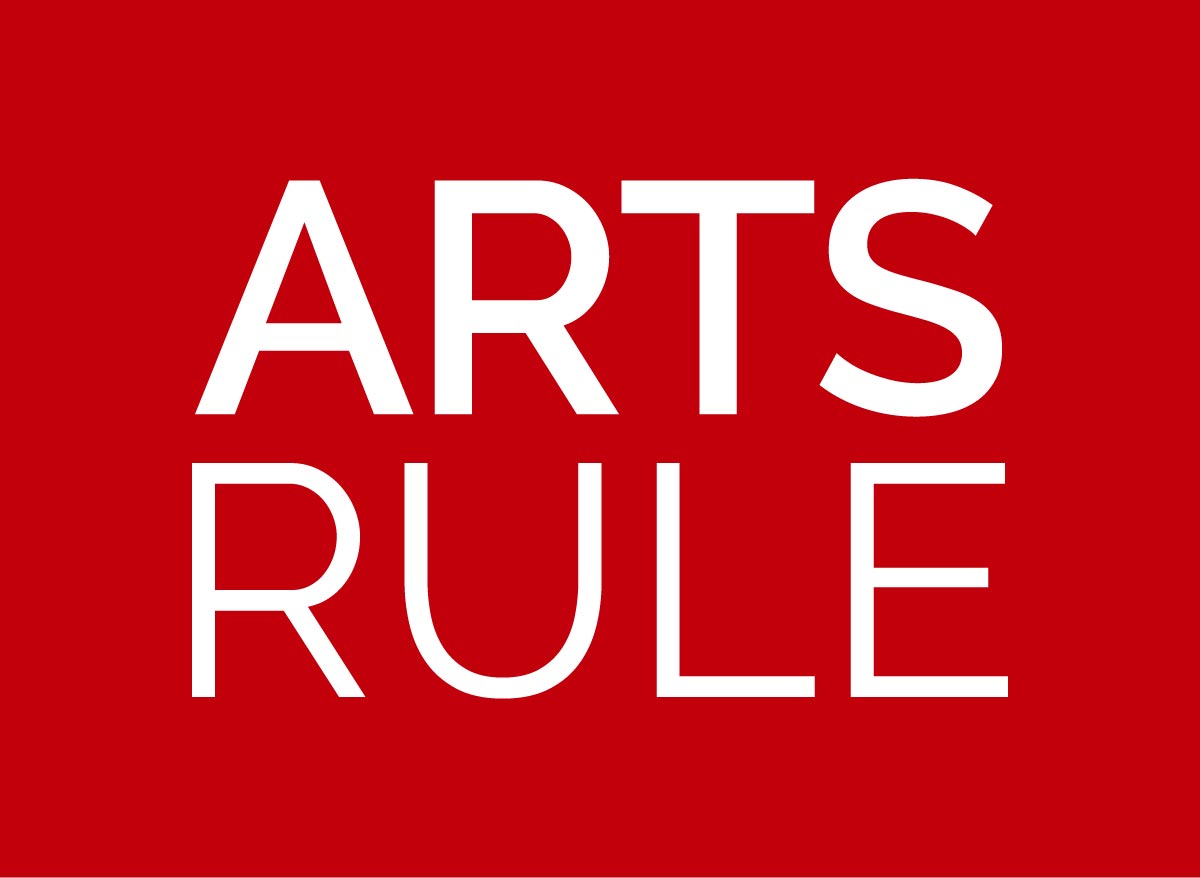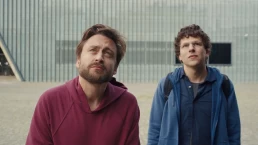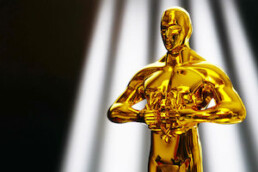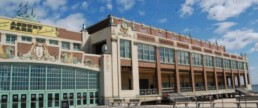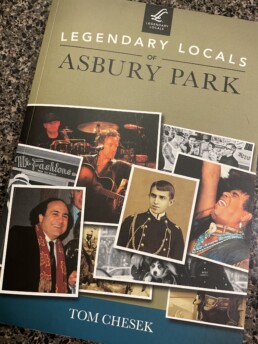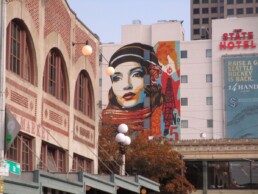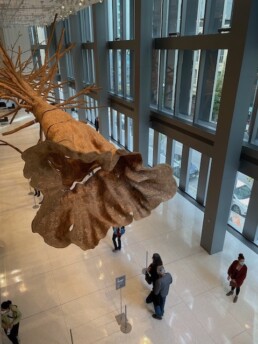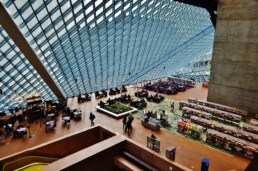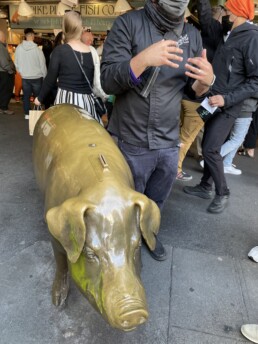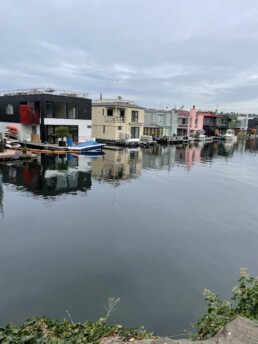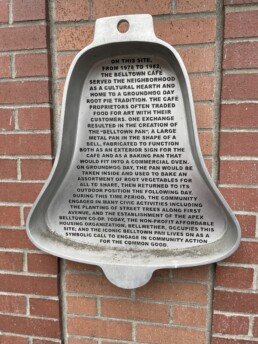Opinion
Movies and More
So, here’s where we’re at on this moment. After a long hiatus, I can declare that movies are coming back. SLOWLY. Forgetting about the much talked about and hyped “Barbenheimer” phenomenon (which really wasn’t a phenomenon at all – they were just two very popular movies that emerged from a desert of inactivity), indies and studios ARE pumping out more product From the looks of it the product is relatively respectable as well I’ll admit, I haven’t seen many of the flicks nominated yet but they’re on my radar and I’m making every attempt to get in a theater to see them BEFORE they hit home screens. I’m still a Luddite when it comes to movies. I ENJOY seeing them on a big screen it’s how they SHOULD be see.
Below are three links to articles of interest – if you’re a movie lover The first is from a NYT article about a relationship and movie influence a different take
The second talks about the winners at Sundance this year and what to look out for when they hit distribution
The third discusses the 2024 Sundance festival as a whole. Sundance, like the movie business overall,too a real hit during COVID-19 and this year has started to see a revitalization.
But will theaters? I just read that a famed theater in Ridgewood I believe has hit the skids and is closing? I know what THAT feels like
Click the links, read the news. Pretty interesting.
Bittersweet, But Looking Forward
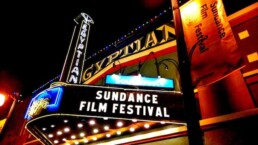
The cold winds are whipping at the Jersey Shore, snow blankets the ground and this time of year always reminds me of being wrapped in Awards Season. It’s that period between Christmas and the Oscars – this year scheduled for March 10th – that kept us warm, cozy and active in the film exhibition business. Listening to the podcasts and reading the industry headlines now, I look back fondly on those weeks of curating the best, most popular, and those films that had a chance to win an award so our audiences could watch them in the comfort of an independent cinema. As a small cinema, the battle was always frantic to attain the right mix against the forces of the major chains.
The Christmas season usually produced two or three contenders that audiences would clamor to see in a theater. The buzz of the Golden Globes, the DGA awards and the frenzy of Sundance continued the box office machine.
Alas, the industry changed through a chance interruption with something called Covid and a pandemic. And we – all of us – changed forever. Or, at least for a long time. Industry prognosticators now peg the cinema slump through 2025. In 2024, audiences now are more likely to stay at home and wait for their selections to arrive on their big screen televisions through the proliferation of streaming services. The thrill of being enveloped in a film in a darkened cinema with your neighbors is long past.
And so is the business of film exhibition. The landscape has changed so dramatically I don’t even recognize it anymore.
Nancy and I are looking forward, though. While most everyone looks back fondly to what we created – and we’re thankful for all your kind words – we’re moving ahead with our current projects in the Asbury Park Arts Council, APTV and the League of Women Voters. ArtsRule still provides us a voice in arts and culture which we’re pleased to continue.
For those of you still watching, Sundance starts tomorrow January 17th. The Oscar nominations are announced on January 23rd. And the Oscar ceremony is March 10th.
If you get a chance, see a movie in a cinema. Please.
Grandest of Sandcastles
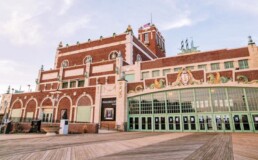
I caught this post recently on FB from our friend and wordsmith Tom Chesek regarding one of Asbury Park’s most iconic buildings: The Convention Hall/Paramount Theater complex that overlooks the ocean. Tom is the author of LEGENDARY LOCALS OF ASBURY PARK, which I strongly urge you to pick up a copy at this link.
Tom’s post provides an interesting perspective on the famed brick building and his writing is, as always, expressed in a style that we haven’t seen duplicated. Tom is truly one of the more quiet creatives here in Asbury and Nancy and I always look forward to his work. We’re glad he resides in Asbury Park as he is an integral participant in the creative community.
TOM CHESEK WRITES:
A reporter from the Asbury Park Press (like so many other folks these days, acting under the mistaken assumption that I’m some kind of official historian/ unimpeachable authority) asked for my thoughts on the city’s Convention Hall…what it means to people; the scenes it’s seen, and oh the places it may or may not go. Here’s what I sent ’em…
Like pretty much any place outside of a handful of immediately recognizable cities, New Jersey can claim very little in the way of “iconic” buildings…and with Lucy the Elephant currently shrouded in scaffolding, it falls upon Asbury Park’s Convention Hall/ Paramount Theatre complex to represent the past and present and hopes and dreams and pride and ambition and ever-complicated collective identity of our Garden State.
Now more than ever it seems, this grandest of sandcastles serves as a split-second signifier in the drone shots of countless commercials and videos. Its colorful brickwork and copper baubles make for a sought-after backdrop to news dispatches (as reported by everyone from local public access personnel to the likes of Anderson Cooper), official pronouncements (from mayor/ council and assemblypersons, to multiple gubernatorial administrations and President Barack Obama), and…in tandem with its fallen sister the Casino…every other area wedding party photo shoot this side of the Deep Cut Gardens pergola.
This is a place…likened by Debbie Harry to “a concrete bathtub” for its notoriously muddy acoustics…that’s resounded with the echoes of countless trade shows, pageants, boxing bouts, wrestling slams, professional basketball games (any love out there for the NJ Shorecats?), grand operas and yes CONVENTIONS, as well as midnight marriages and movie star appearances (The Marx Brothers, Fredric March, Ginger Rogers, hometown favorite son Danny De Vito), tattoo meets and TED talks, flea markets and filmfests, CatCons and of course concerts: The Rolling Stones, Ray Charles, Janis, Dylan, The Duke, The Doors, The Who, The Clash, The (Johnny) Cash, some fella named Bruce, and what was purported to be the nation’s first Rock ‘n Roll Riot.
For a generation-plus of locals like myself, it was the place where you saw your very first concert (Black Sabbath! Well okay, Black Oak Arkansas)…a place where indelible memories were forged, whether on the main floor and upper level walkways, or in many cases on the beach beneath its pilings.
Even in its present, largely silenced and sidelined state, the backdrop to the story continues to become the story in itself…whether suspending all scheduled events during a highly uncertain interlude, or generating a cardboard controversy over the installation of a unique holiday tree (a move that resonated in particular with all those who still don’t get that the building has been private property, and not city property, for decades).
TV-show paranormal investigators seek out traces of the fabled ghosts from the SS Morro Castle disaster; mysteries still swirl about the “Great Copper Caper” disappearance of some irreplaceable architectural features, while the current conflicts between City Hall and the present-day stewards of the structure remain the stuff of local-news headlines and social media kerfuffle.
Even though it’s still shy of a hundred years old, the old castle holds more than its share of tales, you gotta reckon, within and beyond the “secret” spaces where pieces of antique pipe organs and projection equipment dwell…but at the same time, it exists as a place of contemporary commerce, where electronic purchase transactions are booped into the permanent record on the Grand Arcade floor, and where a flight of stairs and an intriguing door lead you to the wired workstations and conference cabanas of the boardwalk’s managers.
Still, in a deliriously dynamic and ever-changing environment where no “landmark point of reference” is necessarily sacred…not even a century-old Roman Catholic church going Luxury Condo…the roller-coaster ride of history will inevitably cast many of its unsecured riders loose, often just seconds after their thrilled faces were snapshotted as they ascended to what they thought was the top of the world.
So appreciate it for it was and maybe will be again, this brick-and-mortar behemoth that has loomed large in our Jersey dreams; this Depression-era land liner that had the audacity to block Founder Bradley’s stony gaze to the seaward horizon; this conveyor of “Greetings from Asbury Park” that has stood fast against so many of the most epic storms of Jersey Shore lore…even as the interfaces of time and tide do their thing in ways that are not always readily apparent to the wonderstruck observer.
Dance in the ghostly sights and sounds of summers past, here in our undisputed Nexus of All Nostalgia…or be among those who are making memories NOW and gazing upon possible futures during this city’s work-in-progress latest chapter. Buy yourself a snack or a souvenir; explore the beach and the boards and the city boulevards that beckon beyond the arcade; take a really deeply detailed look at the up and down and inside and outside of it all…
…and go ahead, TAKE those selfies that say you were there inside that uniquely New Jersey moment. Get that wedding party together and snap away…just don’t get TOO married to these beloved castles made of shifting sand.
Art-less in Seattle
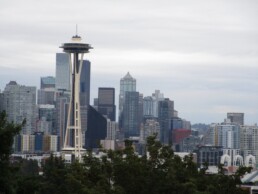
Mike’s View:
I started the trip to Seattle, WA with this view in mind, from the Seattle Visitor website:
“From the moment you set foot in Seattle, you can feel it: art is everywhere. The thriving arts scene is a priority in this city—in fact, Seattle has been recognized for having more arts-related businesses and organizations per capita than any other metropolitan area in the U.S., according to Americans for the Arts.”
Needless to say, we were VERY excited to tour downtown Seattle and feel the vibe. Seattle is no where near the population of Asbury Park – in round numbers 750,000 versus 15,000. not a fair comparison to the seaside town where art is its economic engine. However, upon arriving in the downtown, the impression is more dystopian than artistic. Dozens of very tall buildings are empty, under renovation, for lease or sale. Homeless people wander the streets, sleeping in doorways, modern day zombies.
Time has not been kind to the city that built the Space Needle for the 1962 World’s Fair.
A merchant in the Pioneer Square area, informed us the “city grew too big too fast” and started its descent in 2014. This historically significant area seems the ideal setting for galleries and loft studio space, but really caters to the sports teams and homeless encampments. The pandemic in 2020 was just the capper to throw the city into desolation.
Yet, the latest reports have Seattle booming in the real estate market with companies like Amazon, Expedia, Microsoft and Zillow expanding their roots while Google and Facebook are also setting up shop. But most of this expansion is in outlying neighborhoods away from the downtown. From a street-view, there’s still plenty of space available in the city proper, but a recent NYT article explains otherwise.
Seattle has its hot spots – Pike Place Market is definitely the tourist “boardwalk” akin to AP. Here, the creativity is culinary, with specialty food pairings taking flight among the tourists and buskers. But the claim of arts centricity is, in my opinion, a bit overblown, there was so little evidence of art-at-work on a daily basis, in our four day swing through town, and we were looking for it.
Nancy’s View:
A trip to the Pacific city of Seattle, WA filled up a warm October weekend, when, after our third booster shot, travel seemed less hazardous. Mike and I were excited to visit a city with art, museums and sculpture mingling in the downtown. Coming out of the pandemic, the city seemed poised to resume its self proclaimed position as the most art centric city. But aside from large edifices like Seattle Art museum, a Frank O. Gehry designed Museum of Pop Culture and a Central Library building designed by Rem Koolhaas, we had a hard time finding small galleries, murals or installs in the downtown.
Granted that Pike Market Place – the city’s farmers market and major tourist attraction – has crafts, which have grown up along side the food stalls, indicating that one success (food stalls and restaurants) are capable of spawning others. Buskers on the street corners in front of stores was the only actual example of performance art we found. The brass pig statue is used as a way to fund the marketplace, tourists are encouraged to feed Rachel their spare change for a photo with her.
We were told that tech is bringing in new blood for housing and this young, hardworking population seems focused on good jobs, sports teams and restaurants, not, it seemed on the arts and culture. A city as big as Seattle has soaring rents and major renovations going on downtown but the neighborhoods further away are where growth is visible, as space and community become more desirable than being in the middle of the city.
As in other big cities, smaller neighborhoods further out are being developed with their own personalities, drawing on those who enjoy converted warehouse space, high rise condos, great views or life on the waterways. (photos of house on the water) Art and artists living within communities usually develops because it is a cheap space to live or a good place to sell art to those buying upscale residences.
The museums attract out of town tourists and are unique, well curated and attendance is growing. The art installations are impressive, and the exhibitions crowd pleasing. Quirky outdoor pieces like the troll under the highway bridge, in a local neighborhood, obviously bring tourists. The performing arts are said to be coming back more slowly as with all assembly space functions – theater, dance, concerts – the audience is still reluctant to jump back in, hitting the high attendance numbers of 2018. When asked why the decline in entertainment, most said COVID, but others say the writing was on the wall even before.
Seattle is scrappy, the history tells of rebuilding after floods, fires and earthquakes, and a deep harbor means it has and will continue to be a shipping hub, with cruise ships dropping anchor regularly during the season, as many as 7 in a day! Art flourishes where there is money and Seattle is building as if the money is coming back. We’ll revisit the city in a few years, for now, in my opinion, it has a way to go to having art on the streets in the downtown.
How have you found this city recently?
What Exactly is Arts-Centric?
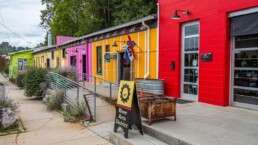
In order for us to look at arts-centric cities, one first has to define what it is we’re talking about.
According to the Eden Gallery, a global network of high end art galleries with multiple locations across the globe, for the most part, “art falls into pretty much seven classical forms: painting, sculpture, literature, architecture, cinema, music, theater.”
If these are the forms of art that enrich our everyday lives, how many are needed to have a city be considered ‘arts-centric’?
What helps creates the perception, either internally or externally, that a city is driven by the arts?
How does one quantify what percentage of a city’s economy is derived from the arts and its art “halo” effect?
Is it more about a vibe and less how much income is generated by the arts?
How do people who live in arts-centric towns feel about their city?
How do the local officials support their city’s focus on the arts?
How do arts-centric cities deal with the popularity brought about by the arts?
These are just some of the discussion points we’ll be exploring throughout these pages in upcoming installments. Stay tuned.
Why Mike and Nancy
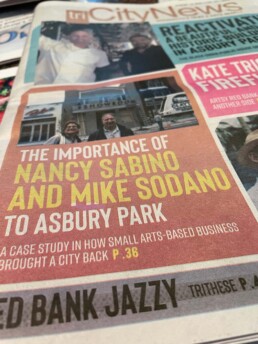
We live in a bubble here in Asbury Park. Since 2009, we’ve tried to be a part of the art and cultural “scene” in the city, specifically by opening up the first movie theater since Walter Reade came into town. And we worked at it, day and night. Pretty much everything we did revolved around the theater and casting a wider net to attract more people to the movies. We never realized what impact we were having on the community until we’d found that people would recognize us as “the movie theater people” and comment about how much they loved the theater and enjoyed the films we showed.
In the 10+ years that we participated in the arts and culture of Asbury Park, then expanded to Bradley Beach, we witnessed some great events, some not-so great events and how the arts color community.
Once the pandemic descended on the world and everything shut down, we became a world with less art – or in some cases, no art. Artists tried to pivot to express themselves during lockdown without a live audience. Funding dried up as it was diverted to other priorities. The arts have always struggled with funding – patrons, sponsors and grants have, up to now, underwritten the cost of public art. But with a pandemic, those same funds were being needed to keep people alive and businesses open, very little is left for the products of the imagination, the heart-felt talents and the manifestations of sensory perception that pour from artistic endeavors and fuel the soul.
We witnessed first-hand the devastating effect of a heath emergency lock down on the arts since our Cinemas were among the first businesses to shut down, and the last business to reopen. As we have moved on from being owners of an arts establishment, we have a unique perspective to view what makes an arts community “tick”, grow, thrive and survive because we did it. We believe we know the questions to ask, the people to seek out and the cross section of individuals who can give us an understanding of what can help rebuild the foundation of an arts community.
Why is this important?
The recent 20th anniversary of the world trade towers terrorist attack puts the re-opening of Broadway into perspective. Back in 2001, Broadway was closed for only three days after the tragedy that shattered NYC. The theaters suffered well beyond those three days, but audiences eventually returned. The pandemic event of 2020 with over 600,000 fatalities has a much longer tail with audiences still staying away from theater, movies, concerts and other indoor events. But they ARE returning slowly, just not in the numbers needed for many businesses to cover their costs, let alone be profitable.
Arts speak the truth in ways humans understand viscerally. Even though it may not seem important to your daily life, the arts are economic engines of many cities – driving tourism to appreciate the arts, employing many and stimulating the economy. Business flourishes in such an environment. While the loss of arts, culture and entertainment is highlighted most noticeably in metropolitan areas such as New York or Los Angeles, it is also the life blood to small cities like Asbury Park. Examination of the success stories and best practices that have come through these hard times may be most needed in the future. We look forward to sharing what we find with you.
